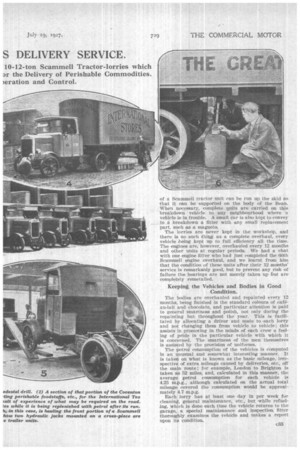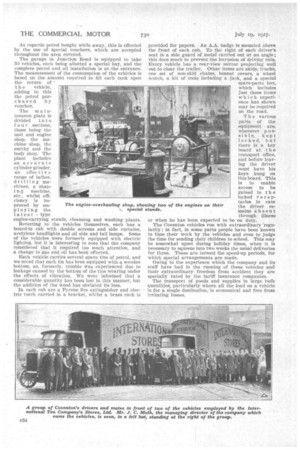12-TONNERS FOR E)a)F S DELIVERY SERVICE.
Page 54

Page 55

Page 56

If you've noticed an error in this article please click here to report it so we can fix it.
Hal are -a-million Miles Per Annum Run by Ti Owned by Coventon's, Ltd., and Mainly U Details of the System
10-12-ton Scammell Tractor-lorries which Jr the Delivery of Perishable Commodities. )eration and Control.
COTE of the most efficient and best-kept fleets of kJ vehicles in this country is that owned by Coventon's, Ltd:, 112a, Junction Road, Upper Holloway, London,N.19, and many have been the expressions of admiration, both as to the vehicles themselves and the way in which they are handled, which we have heard in casual conversation.
All the fleet of 30 goods-carrying vehicles are Scammelts with a load capacity of from 10 tons to 12 tons, and they are provided with insulated boxvan bodies, being mainly employed for the delivery of perishable commodities, foodstuffs, etc.
The area covered by this fleet is the whole of southern England so far as Exeter, and many districts in the north, including Derbyshire and Lincolnshire, and the total mileage per annum is something over half a million, • each lorry on service averaging some 400 miles per week.
Of this fleet the majority of lorries are. employed by the International Tea Co.'s Stores, Ltd., many thousands of tons being carried for this well-known company.
Work of Each Vehicle Allocated for a Fortnight.
All the vehicles start frOM London, and the work of each is allocated for a fortnight. In connection with this allocation, use is made of a simple but interesting and practicable indicating board divided into vertical 'columns for days, with horizontal slides upon which are mounted the indicators for each vehicle, these indicators carrying not the names of the vehicles but their -destinations, so that by looking at the numberof the vehicle at the left and following along the horizontal slide the destination of any vehicle can be seen at a glance.
The men are away from home for three nights a week on the average, ample allowances being made for out-money and garage. The work may be termed specialized, and the rates of pay are correspondingly high. A very interesting point in connection with the drivers is that each is insured for £100 in the event of decease, this money going to the next of kin. In the event of the drivers being summoned for exceeding the speed limit and to meet the fines,-a fund centributed to equally by the men and the company is called upon.
The nature of the work is such that the fleet is wholly .engaged for the five days a week-, but main
tena reph redu stra rare equi lorr hydr light ce being on the unit system, any unit can be ced with extraordinary rapidity, and to assist in 'ng the time during which any vehicle may be ded on the road (which, incidentally, is of very occurrencea. Special breakdown plant is included art of the fleet equipment It is a Bean van, ped with a winch inside the forward end of the body, also with a lifting tackle and a double ulic jack capable of lifting up to 15 tons; electric are provided for working in the dark.
e of our illustrations shows how the forward end
of a Scammell tractor unit can be run up the skid so that it can be supported on the body of the Bean. When necessary, complete units are carried on this breakdown vehicle to any neighbourhood where a vehicle is in trouble. A small car is also kept to convey to a breakdown a fitter with any small replacement part, such as a magneto.
The lorries are never kept in the workshop, and there is no such thing as a complete overhaul, every vehicle being kept up to full efficiency all the time. The engines are, however, overhauled every 12 months and other units at regular periods. We had a chat with one engine fitter who had just completed the 60th Scammell engine overhaul, and we learnt from him that the condition of these units after their 12 &ninths' service is remarkably good, but to prevent any risk of failure the bearings are not merely taken up but are completely remetalled.
Keeping the Vehicles and Bodies in Good Condition.
The bodies are overhauled and repainted every 12 months, being finished in the standard colours of cafeau-lait and chocolate, and particular attention is paid to general smartness and polish, not only during the repainting but throughout the year. This is facilitated by allocating a driver and mate to each lorry and not changing them from vehicle to vehicle; this assists in promoting in the minds of each crew a feeling of pride in the particular vehicle with which it is concerned. The smartness of the men themselves is assisted by the provision of uniforms.
The petrol consumption of the vehicles is computed in an unusual and somewhat interesting manner. It is taken on what is known as the basic mileage, irrespective a extra mileage caused by deliveries, etc., off the main route; for example, London to Brighton is taken as 52 miles, and, calculated in this manner, the average petrol consumption for each vehicle is 4.25 m.p.g., although calculated on the actual total mileage covered the consumption would be approximately 4.7 m.p.g.
Each lorry has at least one day in per week for cleaning, general maintenance, etc., but while refueling, which is done each time the vehicle returns to the garage, a special maintenance and inspection. fitter thoroughly examines the vehicle and Makes a report upon its condition.
As regards petrol bought while away, this is effected by the use of special vouchers, which are accepted throughout the area covered.
The garage in Junction Road is equipped to take 30 vehicles, each being allotted a special bay, and the complete petrol and oil installation is at the entrance. The ineasur.ement of the consumption of the vehicles is based on the amount required to fill each tank upon the return of t h e vehicle, .adding to this the petrol purchased by voucher.
The maintenance plant is 'divided into four sections, these being the unit and engine shop, the machine, shop, the smithy and the body shop. The plant includes an accurate cylinder grinder, an effective range of lathes, drilling machines, a snap
n g machine, etc., whilst effi ciency is improved by em ploying the latest type engine-carrying stands, cleansing and washing plants.
Reverting to the vehicles themselves, each has a boxed-in cab with double screens and side curtains, acetylene headlights and oil side and tail lamps. Some of the vehicles were formerly equipped with electric lighting, but it is interesting to note that the company considered that it required too much attention, and a change to-as and oil has been effected.
Each vehicle carries several spare tins of petrol, and we noted that each tin has been equipped with a wooden. bottom, as, formerly, trouble was experienced due to leakage caused by the bottom of the tins wearing under the effects of vibration. We were informed that a considerable quantity has been lost in this manner, but the addition of the wood has obviated its loss.
In each cab are a Pyrene fire extinguisher and electric torch carried in a bracket, whilst a brass rack is provided for papers. An A.A. badge is mounted above the front of each cab. To the right of each driver's seat is a side guard of metal carried out at an angle; this does much to prevent the intrusion of driving rain. Every vehicle has a rear-view mirror projecting well out to clear the trailer. Other items are skids, trucks, one set of . non-skid chains, bonnet covers, a wheel Scotch, a kit of tools including a jack, and a special spare-parts box, which includes just those items which experience has shown may be required on the road.
The various parts of the equipment are, wherever p o s
bl e, kept locked, but there is a key board at the transport office, and before leavipg the driver must have his keys hung on this board. This is to enable access to be gained to the locked recep
tacle in case the driver remains absent through illness or when he has been expected to be on duty.
The Coventon vehicles run with extraordinary 'regularity; in fact, in some parts people have been known to time their work by the vehicles and even to judge the time for sending their children to school. This 'nay be Somewhat upset during holiday times, when it is necessary to squeeze into two weeks the usual deliveries for three. These are termed the speed-up periods, for which special arrangements are made.
Owing to the experience which the company and its staff have had in the running of these vehicles and their extraordinary freedom from accident they are specially rated by the tariff insurance companies.
The transport of goods and supplies in large bulk quantities, particularly where all the load on a vehicle is for a single de.stination, is economical and free from irritating losses.












































































































